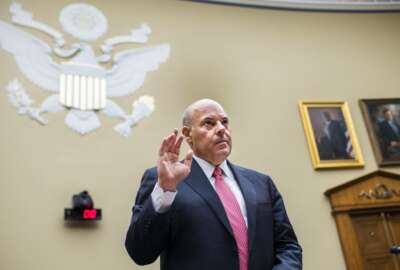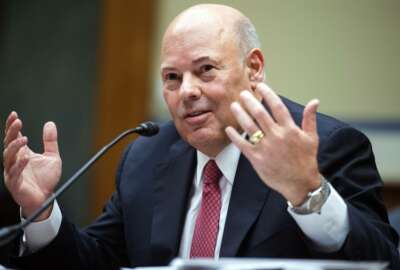DeJoy outlines USPS plans to close, consolidate facilities across its delivery network
The Postal Service is looking to restructure its network of facilities in its delivery network as part of an ongoing effort to improve its long-term financial...
The Postal Service is looking to restructure its network of facilities in its delivery network as part of an ongoing effort to improve its long-term financial health.
DeJoy said Monday that USPS is showing progress under its 10-year reform plan by reducing costs and increasing revenue, but will need to continue its trajectory by closing and consolidating facilities across its delivery network.
The agency, he added, has decreased its forecasted losses by at least $100 billion over the coming years, and is more than halfway toward a goal of reaching break-even status, after 15 years of net financial losses.
“We are a better organization, in a better financial position, than we were just one year ago,” DeJoy said in a keynote address at the National Postal Forum in Phoenix.
DeJoy said USPS is on track to becoming financially sustainable in 2024, and will achieve 95% on-time performance across its product categories that same year.
As for the next steps under the agency’s 10-year reform plan, DeJoy said USPS will realign its network of processing facilities and improve the route structure its carriers rely on to deliver to 161 million addresses every day.
DeJoy said the overhaul of its delivery network will streamline how USPS delivers mail and packages in a way that will reduce costs and improve revenue.
“We process mail and packages in a complicated, illogical, redundant and inefficient way,” DeJoy said. “To compound this, our facilities are in disrepair, lack adequate space and equipment and are not suitable to the implementation of standard operating practices and measurements,” DeJoy said.
The network transformation initiative will impact nearly 500 network mail processing locations, 1,000 transfer hubs and 100,000 carrier routes. It will also impact 10,000 delivery units, which USPS defines as post offices, stations, branches or carrier annexes that handle mail delivery functions.
“These delivery units are in disrepair. They have poor employee amenities, have not accommodated our package growth, and operate to a dated and costly strategy,” DeJoy said. “Dramatic change is needed, and dramatic change is what we are pursuing.”
DeJoy said USPS will consolidate delivery operations into Sort and Delivery Centers, with enough space, docks and mail processing equipment to operate more efficiently than its current infrastructure.
“We will place large carrier operations inside our mail processing plants, dramatically reducing transportation, reducing mail handlings, increasing reliability, and decreasing time to delivery,” DeJoy said.
As part of this plan, DeJoy said USPS will close annexes around the country “that add cost, transportation, and foster inefficient and ad-hoc operations.” Annexes are USPS facilities separate from post offices used for mail delivery functions, but may not offer full retail services to customers.
DeJoy said these changes to the USPS network and local operations will take years to accomplish, but said each plant and delivery unit included in this overhaul “will provide immediate, systemwide benefits.”
“This will transform the Postal Service, and I wish I could say it is ingenious. It is not — it is obvious. If you were building a Postal Service from scratch today, this is what you would do. The genius is unwinding what we are doing today to prepare for the future,” DeJoy said.
DeJoy said USPS has almost 19,000 facilities in its delivery network. In some areas, he said there are more than 40 locations within a 10-mile radius.
“This requires significant sorting of product at our plants, numerous underutilized truckloads, and diminishes the magnificence of our biggest competitive advantage — our mail carrier route structure,” he said.
DeJoy said USPS is analyzing its inventory of closed plants, and plans to modernize some of them to accommodate this strategy.
USPS, DeJoy said, is trying to get ahead of more than a decade in which the agency “significantly under-invested in its infrastructure.”
He said that prior to the 10-year reform plan, USPS was spending $1.7 billion a year on infrastructure, with much going toward replacing roofs on old buildings, but left little to invest in USPS plans, technology and equipment.
DeJoy previewed the agency’s facilities overhaul in an interview last month. During that interview, DeJoy said that USPS employees faced a “terrible operating environment” in old, dark facilities, and that upgrades were necessary to improve workforce morale.
“Let there be light, and I mean this literally,” DeJoy said during Monday’s keynote. “Let there be light inside postal plants, as this new environment will improve performance, lower cost, reduce stress and improve morale.”
DeJoy said USPS is also looking to gain efficiency in its competitive package business through increased automation, and by integrating the delivery of mail and package volume across its network, as mandated by recently signed postal reform legislation.
“It is not an expansion of a package network. It is an increase in the utilization of what we now do to deliver mail. In fact, we have the ability to use less transportation and fewer processing facilities and fewer delivery units, and greatly increase the movement of cubic volume, meaning mail and packages,” he said.
DeJoy said USPS moves “a whole lot of air” through an inefficient transportation network, and said the agency can reduce its costs by relying on less transportation and fewer processing facilities to deliver mail and packages.
While USPS has seen a significant increase in package revenue since the start of the COVID-19 pandemic, DeJoy said the core of the 10-year reform plan is “saving our mail business,” building a package-centric business.
“I often hear that we are not doing enough about mail. I respectfully disagree. This plan is all about mail. The Postal Service is all about mail,” DeJoy said. “The fact of the matter is, we have failed to adequately adjust to declining mail revenue. We need time to restructure our costs and supplement our revenue stream to fulfill our primary mission of delivering mail.”
DeJoy said earlier this month that the mailing industry needs to prepare for USPS raising prices on its market-dominant mail products “at an uncomfortable rate,” until it reaches a point where the agency is on track to be self-sustaining in the long term.
During his keynote, however, he said these price increases will eventually level off once the agency’s financial condition improves.
“There will come a point in time when we have achieved our objectives of cost and service equilibrium. At that time, you will have both a vibrant Postal Service and affordable market-dominant prices, and it is only this equilibrium that works under the rules that Congress gave us,” DeJoy said.
While President Joe Biden recently signed the Postal Service Reform Act, which is expected to save USPS $107 billion in total, DeJoy said years of “inaction and obstruction” from Congress, regulators, management and others kept USPS from adapting to market trends over the years.
Had USPS reform legislation or greater pricing flexibility from its regulator happened sooner, DeJoy said the agency’s financial condition might have grown so dire, and that the agency’s operations and infrastructure budget would not have been stretched so thin.
“All I can say is year after year, the Postal Service was allowed to be overwhelmed. And the consequence to our institution is significant,” he said.
Copyright © 2025 Federal News Network. All rights reserved. This website is not intended for users located within the European Economic Area.
Jory Heckman is a reporter at Federal News Network covering U.S. Postal Service, IRS, big data and technology issues.
Follow @jheckmanWFED






